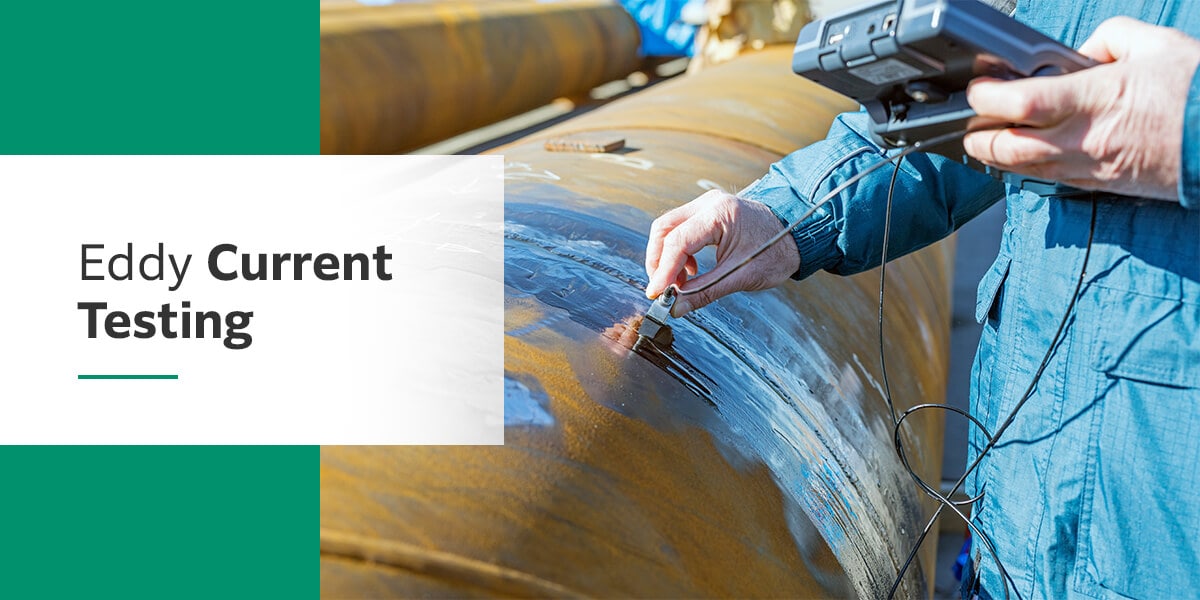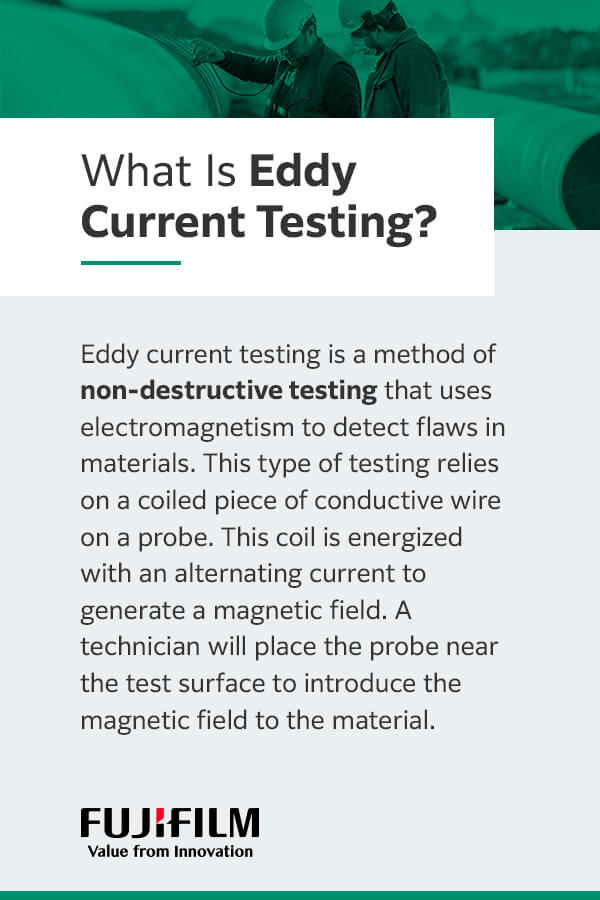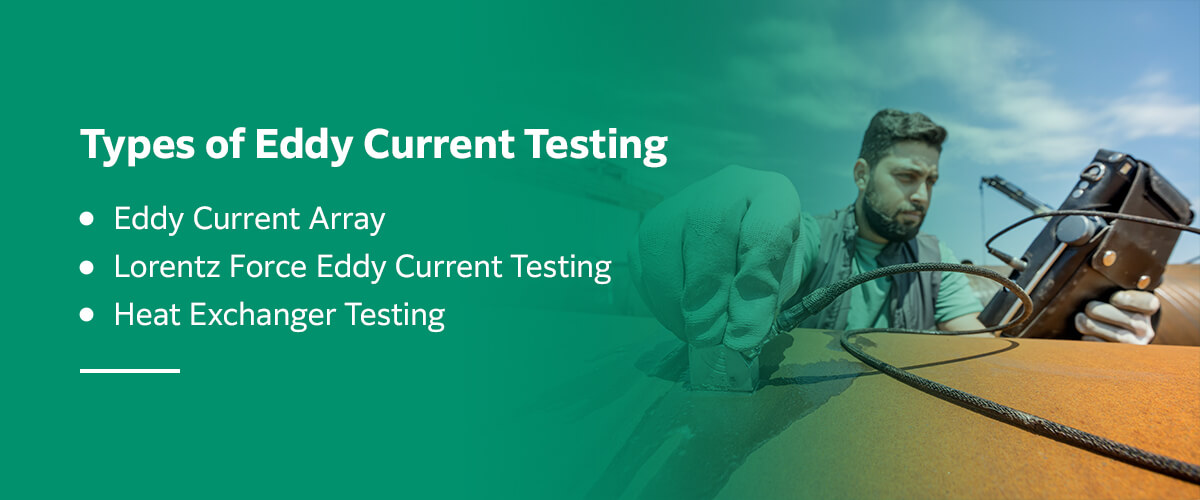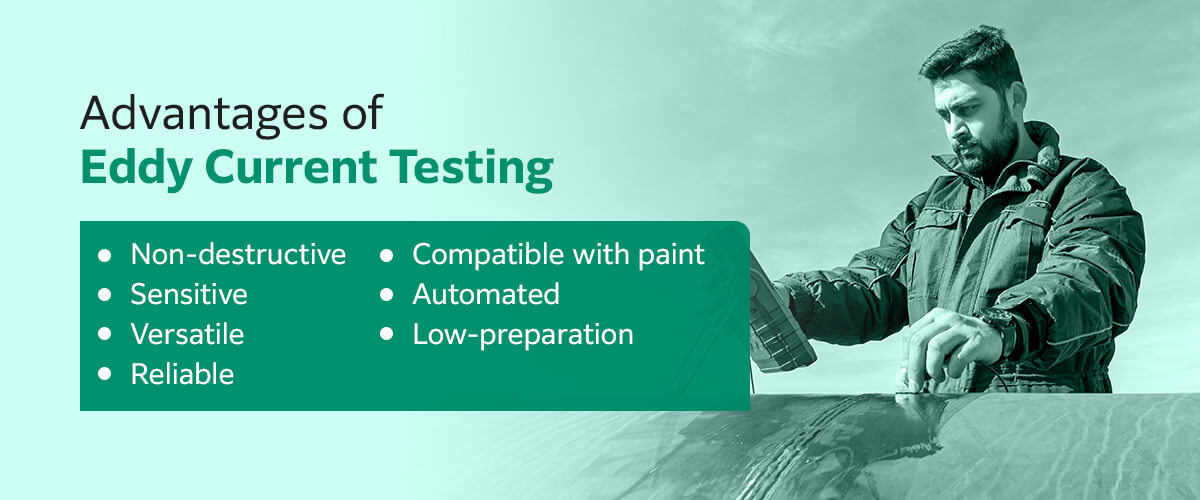What Is Eddy Current Testing?

Jump to:
- What Is Eddy Current Testing?
- How Does Eddy Current Testing Work?
- What Is Eddy Current Testing Used For?
- Types of Eddy Current Testing
- Advantages of Eddy Current Testing
- Disadvantages of Eddy Current Testing
There are many approaches to detecting defects in components in the world of non-destructive testing (NDT). Some forms of NDT rely on visual inspections, magnetic particles or radiography. Non-destructive testing is a valuable tool in developing accurate components, and learning about the types can uncover valuable means of inspecting material quality.
Eddy current testing (ECT) is one of many NDT methods, and it’s well-known for its sensitivity and reliability. Understanding the ECT process can help you determine if it’s the appropriate NDT method for your inspection needs.
What Is Eddy Current Testing?

Eddy current testing is a method of non-destructive testing that uses electromagnetism to detect flaws in materials. This type of testing relies on a coiled piece of conductive wire on a probe. This coil is energized with an alternating current to generate a magnetic field. A technician will place the probe near the test surface to introduce the magnetic field to the material.
During this interaction, eddy currents will develop in the vicinity. Inspectors measure the behaviors of these eddy currents with a data collection tool. These data collection tools are typically portable, and they may hook up to a computer to display a graph of eddy current behaviors.
Once the process is complete, a specialized professional — often different from the tester — can read the collected data and determine if there are any flaws present. The data interpretation stage is vital for deciding which current behaviors indicate a defect.
How Does Eddy Current Testing Work?
Eddy current testing relies on electromagnetic induction and the concept described in Lenz’s law. The probe used in ECT uses a conductor with an alternating current, thus creating a magnetic field around the object. As the alternating current rises and falls, this field expands and contracts.
When this conductor and its magnetic field get close enough to another electrical conductor, the field can permeate the newly introduced material. As stated in Lenz’s law, when this introduction occurs, the magnetic field induces an eddy current. These eddy currents run in the opposite direction of the current introduced by the probe, creating a secondary magnetic field and affecting the current and voltage flowing through the probe’s conductor.
Changes to conductivity, like changes in thickness and surface defects, will modify the eddy current’s magnitude. Either the primary coil or a second detecting device is used to track these changes.
Eddy currents have higher density and sensitivity at the surface of a conductive material, and these factors decrease with depth. Permeability — the ease at which a material can be magnetized — and conductivity will affect how well the eddy currents will respond to defects. When inspectors apply this technique, they have to determine the best frequency for the necessary penetration and sensitivity with the testing material.
Inspectors must be thoroughly trained to complete an eddy current test. A qualified professional will abide by the standards set out by varying governing bodies. Abiding by these standards is expected in all forms of NDT. Since operations rely on accurate results, the testing procedure must also be accurate.
There are several standards that outline best practices and requirements, but the main governing bodies are:
- The American Society of Mechanical Engineers (ASME)
- American Society for Testing and Materials (ASTM)
- International Organization of Standards (ISO)
What Is Eddy Current Testing Used For?
The application of eddy current testing is wide-ranging. Its high sensitivity makes it valuable for detecting very small cracks and defects in various ferromagnetic and non-ferromagnetic surfaces. The types of flaws eddy current testing can detect include:
- Cracks
- Wear from erosion
- Damage caused by freezing
- Corrosion
- Wall or thickness loss
- Pitting
- Lack of fusion
ECT is often used to inspect tubing, like metal tube components and steam generator tubing. Due to higher material thickness, tubing inspections work best with non-ferromagnetic materials. Other common materials that undergo inspection with ECT include:
- Welded joints
- Friction stir welds
- Bolt hole bores
- Nozzle welds
Industries like oil and gas, aerospace, power generation, automotive and manufacturing rely on ECT to ensure the accuracy and safety of many materials and components.
Types of Eddy Current Testing
When an inspector leads an eddy current testing procedure, they must decide what type of method to use. There are several approaches to the process, and each procedure works well for different materials and requires various tools to complete. One of the most notable differences in these methods is the probe types they use.
ECT’s versatility makes it easy to choose a method that will deliver the best results for the test material at hand.
Eddy Current Array
Eddy current array (ECA) uses a series of coils to cover a larger area in a single pass than the standard, single-coil probe. Generally, a line of coils like this comes with the risk of mutual inductance when two coils are activated next to each other. This mutual inductance could then affect the results of the inspection.
ECA addresses the potential for mutual inductance with a process called multiplexing. In this process, the coils activate and deactivate in specific sequences to make use of the probe’s complete width. These sequences are designed to minimize the interference between coils while optimizing the probe’s resolution.
As opposed to single-coil eddy current testing, ECA offers:
- Wider coverage
- Stronger detection abilities
- Faster inspections
- Flexible probe designs
- Consistent results
While ECA equipment is ideal for gaining comprehensive data about surface flaws, operators will need additional training to run the inspections. In addition to more required experience, ECA comes with a longer setup time than a standard ECT. While the inspection itself is faster, the overall time difference may not be notable.
Lorentz Force Eddy Current Testing
Lorentz force ECT is a relatively new testing method. This approach uses a permanent magnet in relative motion to the component under test. The relative movement introduces the eddy currents in accordance with Ohm’s law for moving conductors.
If there is a defect in the material, the disturbance in the eddy currents or the secondary magnetic field is detected by the Lorentz force acting on the permanent magnet. This method is meant to address a common problem in standard ECT — the skin effect. This effect refers to a current’s tendency to crowd at the surface of a conductive material, limiting inspection capabilities.
While Lorentz force ECT is novel, it can offer accurate test results with more depth than a standard eddy current test.
Heat Exchanger Testing
This eddy current testing method is designed specifically for inspecting heat exchanger tubes, and it’s one of the most popular types. Heat exchangers are used in wastewater treatment, chemical, nuclear and other plants for heating and cooling industrial processes. These tubes are often exposed to high fluid pressure, leading to pitting, cracking, corrosion and other surface and subsurface flaws.
There are two methods of heat exchanger testing. Internal rotary inspection system (IRIS) uses ultrasonic waves, so it’s a different type of NDT from ECT. Remote field testing (RFT) is the electromagnetic testing option.
In this method, the RFT probe has one or a series of transmitter coils and a receiver coil. The receiver coil sits inside the tube, and the transmitter coil sits on the outside. The magnetic field created by the transmitter coil must travel through the tube wall to the receiver. The field passes back and forth for detecting internal and external defects.
These coils create a direct and indirect path. The direct path is created by circumferential eddy currents inside the tube’s wall. The indirect path is made of the transmitter’s magnetic field that diffuses radially outward and through the tube wall. This field then spreads rapidly along the tube wall. If there are anomalies in the indirect path, like magnitude changes, these behaviors indicate defects.
Surface Array Testing
Surface array testing is a type of ECT that is most often used in the aerospace industry. This method excels at detecting corrosion and wall thickness changes with high accuracy, and it can measure conductivity.
This approach uses the current array probe as seen in ECA, but it includes a corrosion mapping aspect to create a clear picture of pitting and thickness changes in stainless steel surfaces. This method can often find defects where other approaches can’t, making it the method of choice for high-accuracy applications.
Surface array probes typically feature a flexible design, equipping them to handle surfaces that aren’t flat.
Advantages of Eddy Current Testing
Eddy current testing offers a range of benefits for operations across industries. Companies choose ECT because it’s:
- Non-destructive: As a non-destructive testing method, ECT is a valuable inspection method. The process will not damage the component during the inspection, which is beneficial for two reasons. If the component is currently in use, it can continue performing its job. In addition, maintaining the integrity of the piece allows engineers to inspect the component and make modifications to the design for improved performance.
- Sensitive: ECT offers extensive sensitivity, which makes it ideal for detecting extremely small surface and subsurface defects. In industries like aerospace, where high-level accuracy is a priority, ECT’s sensitivity ensures operations can meet rigorous quality standards.
- Versatile: Eddy current testing is highly versatile, making it accessible to many types of operations and testing requirements. The equipment is portable, making it easy for inspectors to travel to various locations for conducting the test. The various testing procedures support accuracy for a range of components, and the test performs well in high temperatures and underwater.
- Reliable: The use of electromagnetism allows for charting and data collection of the inspection, which is not the case for all NDT types. This data collection offers more reliability since the results are not left entirely to human perception.
- Compatible with paint: Some NDT methods, like magnetic particle inspection, require the removal of paint layers for accurate readings. ECT works with all paints and coatings. This is beneficial when components are undergoing maintenance and need to keep their protective layers and appearance for continued use.
- Automated: While not every eddy current test is automated, the nature of the testing lends itself to automation should you need it. Many operations rely on automated eddy current testing for uniform parts, like wheels or boiler tubes. ECT then becomes a regular aspect of scheduled maintenance.
- Low-preparation: Components require minimal cleaning to prepare for testing, which is helpful for inspection efficiency. In addition to minimal prepping requirements, the inspection will deliver immediate results, getting information to operations sooner.
Disadvantages of Eddy Current Testing
While ECT can be a beneficial approach to NDT, it does have limitations. Some of the disadvantages include:
- Data interpretation: Eddy current testing is advantageous because of its data collection aspect, especially since other NDT methods lack this feature. However, data collection can also be a drawback. When an inspector performs ECT, the result is a graph with varying waves. Often, the changes in these waves will represent a defect in the material, but not always. Sometimes, the eddy currents will pick up on small material textures and other non-relevant data points, and it takes trained interpretation to eliminate these changes. If your inspector lacks the interpretation skills, you may not get the accuracy you need.
- Material limitations: During an ECT, the current can be subject to changes in magnetic permeability, which can make it more challenging to use on ferromagnetic materials that lack constant relative permeability. ECT is also non-conductive with ferromagnetic materials.
- Area: If you need to inspect a large area, ECT is not the best approach. While electromagnetism offers an accurate and sensitive scan, the currents can only offer accuracy to a certain point. Using ECT on larger surfaces requires several points of contact with the probe to give a thorough reading of an entire component.
- Detection failures: An ECT current always runs parallel to the surface of a material. If a defect doesn’t come in direct contact with the current, it will go undetected. It’s very possible for defects to run parallel with the surface themselves, making them undetectable to the current.
Though ECT comes with its disadvantages, there are other NDT methods that can fill in these performance gaps and possible challenges. Working with a professional trained in NDT can help you achieve the inspection accuracy your operation requires, whether you opt for ECT or another procedure.
Trust Fujifilm for Non-Destructive Inspection Services
With the many benefits of eddy current testing, many operations rely on its capabilities. Whether you operate in oil and gas, transportation or aerospace, ECT can be a valuable aspect of project development and component maintenance.
At Fujifilm, we understand the importance of carrying the right tools for eddy current testing and other forms of NDT. Our product lineup for NDT equipment features radiography systems and conventional X-Ray machines to suit your NDT needs.
In addition to our equipment, we prepare your team with our NDT training services. Knowing how to use inspection equipment is critical for accurate results. Our company offers decades of industry experience to ensure our training programs are comprehensive. Our instructors teach according to relevant industry standards and bring their real-world experiences to the classroom.
To learn more about our products and training services, get in touch with us today.













